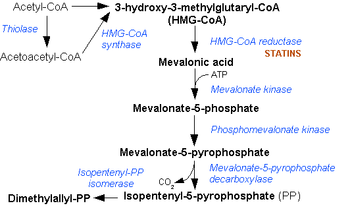
HMG-CoA synthase
Encyclopedia
In molecular biology, HMG-CoA synthase is an enzyme which catalyzes the reaction in which Acetyl-CoA
condenses with acetoacetyl-CoA
to form 3-hydroxy-3-methylglutaryl-CoA (HMG-CoA). It is the second reaction in the mevalonate-dependent isoprenoid biosynthesis
pathway. HMG-CoA is an intermediate in both cholesterol synthesis and ketogenesis
. This reaction is over-activated in patients with diabetes mellitus type 1
if left untreated, due to prolonged insulin
deficiency and the exhaustion of substrates for gluconeogenesis
and the TCA cycle, notably oxaloacetate. This results in shunting of excess acetyl-CoA into the ketone synthesis pathway via HMG-CoA, leading to the development of diabetic ketoacidosis
.

residue that acts as a nucleophile
in the first step of the reaction: the acetylation
of the enzyme
by acetyl-CoA
(its first substrate
) to produce an acetyl-enzyme thioester
, releasing the reduced
coenzyme A
. The subsequent nucleophilic attack on acetoacetyl-CoA
(its second substrate) leads to the formation of HMG-CoA
.
and certain bacteria
.
.
and other sterolic and isoprenoid compounds).

of ketone bodies
. The gene
for the mitochondrial form of the enzyme has three sterol regulatory elements in the 5' flanking region. These elements are responsible for decreased transcription
of the message responsible for enzyme synthesis when dietary cholesterol is high in animals: the same is observed for 3-hydroxy-3-methylglutaryl-CoA and the low density lipoprotein receptor.

, isoprenoid precursors are generally synthesised via an alternative, non-mevalonate pathway, however a number of Gram-positive
pathogen
s utilise a mevalonate pathway involving HMG-CoA synthase that is parallel to that found in eukaryotes
.
Acetyl-CoA
Acetyl coenzyme A or acetyl-CoA is an important molecule in metabolism, used in many biochemical reactions. Its main function is to convey the carbon atoms within the acetyl group to the citric acid cycle to be oxidized for energy production. In chemical structure, acetyl-CoA is the thioester...
condenses with acetoacetyl-CoA
Acetoacetyl-CoA
Acetoacetyl CoA is the precursor of HMG-CoA in the Mevalonate pathway, which is essential for cholesterol synthesis. It also takes a similar role in the ketone bodies synthesis pathway of the liver...
to form 3-hydroxy-3-methylglutaryl-CoA (HMG-CoA). It is the second reaction in the mevalonate-dependent isoprenoid biosynthesis
Biosynthesis
Biosynthesis is an enzyme-catalyzed process in cells of living organisms by which substrates are converted to more complex products. The biosynthesis process often consists of several enzymatic steps in which the product of one step is used as substrate in the following step...
pathway. HMG-CoA is an intermediate in both cholesterol synthesis and ketogenesis
Ketogenesis
Ketogenesis is the process by which ketone bodies are produced as a result of fatty acid breakdown.-Production:Ketone bodies are produced mainly in the mitochondria of liver cells. Its synthesis occurs in response to low glucose levels in the blood, and after exhaustion of cellular carbohydrate...
. This reaction is over-activated in patients with diabetes mellitus type 1
Diabetes mellitus type 1
Diabetes mellitus type 1 is a form of diabetes mellitus that results from autoimmune destruction of insulin-producing beta cells of the pancreas. The subsequent lack of insulin leads to increased blood and urine glucose...
if left untreated, due to prolonged insulin
Insulin
Insulin is a hormone central to regulating carbohydrate and fat metabolism in the body. Insulin causes cells in the liver, muscle, and fat tissue to take up glucose from the blood, storing it as glycogen in the liver and muscle....
deficiency and the exhaustion of substrates for gluconeogenesis
Gluconeogenesis
Gluconeogenesis is a metabolic pathway that results in the generation of glucose from non-carbohydrate carbon substrates such as lactate, glycerol, and glucogenic amino acids....
and the TCA cycle, notably oxaloacetate. This results in shunting of excess acetyl-CoA into the ketone synthesis pathway via HMG-CoA, leading to the development of diabetic ketoacidosis
Diabetic ketoacidosis
Diabetic ketoacidosis is a potentially life-threatening complication in patients with diabetes mellitus. It happens predominantly in those with type 1 diabetes, but it can occur in those with type 2 diabetes under certain circumstances...
.

Mechanism
HMG-CoA synthase contains an important catalytic cysteineCysteine
Cysteine is an α-amino acid with the chemical formula HO2CCHCH2SH. It is a non-essential amino acid, which means that it is biosynthesized in humans. Its codons are UGU and UGC. The side chain on cysteine is thiol, which is polar and thus cysteine is usually classified as a hydrophilic amino acid...
residue that acts as a nucleophile
Nucleophile
A nucleophile is a species that donates an electron-pair to an electrophile to form a chemical bond in a reaction. All molecules or ions with a free pair of electrons can act as nucleophiles. Because nucleophiles donate electrons, they are by definition Lewis bases.Nucleophilic describes the...
in the first step of the reaction: the acetylation
Acetylation
Acetylation describes a reaction that introduces an acetyl functional group into a chemical compound...
of the enzyme
Enzyme
Enzymes are proteins that catalyze chemical reactions. In enzymatic reactions, the molecules at the beginning of the process, called substrates, are converted into different molecules, called products. Almost all chemical reactions in a biological cell need enzymes in order to occur at rates...
by acetyl-CoA
Acetyl-CoA
Acetyl coenzyme A or acetyl-CoA is an important molecule in metabolism, used in many biochemical reactions. Its main function is to convey the carbon atoms within the acetyl group to the citric acid cycle to be oxidized for energy production. In chemical structure, acetyl-CoA is the thioester...
(its first substrate
Substrate (biochemistry)
In biochemistry, a substrate is a molecule upon which an enzyme acts. Enzymes catalyze chemical reactions involving the substrate. In the case of a single substrate, the substrate binds with the enzyme active site, and an enzyme-substrate complex is formed. The substrate is transformed into one or...
) to produce an acetyl-enzyme thioester
Thioester
Thioesters are compounds with the functional group C-S-CO-C. They are the product of esterification between a carboxylic acid and a thiol. Thioesters are widespread in biochemistry, the best-known derivative being acetyl-CoA.-Synthesis:...
, releasing the reduced
Redox
Redox reactions describe all chemical reactions in which atoms have their oxidation state changed....
coenzyme A
Coenzyme A
Coenzyme A is a coenzyme, notable for its role in the synthesis and oxidation of fatty acids, and the oxidation of pyruvate in the citric acid cycle. All sequenced genomes encode enzymes that use coenzyme A as a substrate, and around 4% of cellular enzymes use it as a substrate...
. The subsequent nucleophilic attack on acetoacetyl-CoA
Acetoacetyl-CoA
Acetoacetyl CoA is the precursor of HMG-CoA in the Mevalonate pathway, which is essential for cholesterol synthesis. It also takes a similar role in the ketone bodies synthesis pathway of the liver...
(its second substrate) leads to the formation of HMG-CoA
HMG-CoA
HMG-CoA is an intermediate in the Mevalonate pathway. It is formed from acetyl CoA and acetoacetyl CoA by HMG-CoA synthase.HMG-CoA reductase converts it into mevalonic acid....
.
Species distribution
HMG-CoA synthase occurs in eukaryotes, archaeaArchaea
The Archaea are a group of single-celled microorganisms. A single individual or species from this domain is called an archaeon...
and certain bacteria
Bacteria
Bacteria are a large domain of prokaryotic microorganisms. Typically a few micrometres in length, bacteria have a wide range of shapes, ranging from spheres to rods and spirals...
.
Eukaryotes
In vertebrates, there are two different isozymes of the enzyme (cytosolic and mitochondrial); in humans the cytosolic form has only 60.6% amino acid identity with the mitochondrial form of the enzyme. HMG-CoA is also found in other eukaryotes such as insects, plants and fungiFungus
A fungus is a member of a large group of eukaryotic organisms that includes microorganisms such as yeasts and molds , as well as the more familiar mushrooms. These organisms are classified as a kingdom, Fungi, which is separate from plants, animals, and bacteria...
.
Cytosolic
The cytosolic form is the starting point of the mevalonate pathway, which leads to cholesterolCholesterol
Cholesterol is a complex isoprenoid. Specifically, it is a waxy steroid of fat that is produced in the liver or intestines. It is used to produce hormones and cell membranes and is transported in the blood plasma of all mammals. It is an essential structural component of mammalian cell membranes...
and other sterolic and isoprenoid compounds).

Mitochondrial
The mitochondrial form is responsible for the biosynthesisBiosynthesis
Biosynthesis is an enzyme-catalyzed process in cells of living organisms by which substrates are converted to more complex products. The biosynthesis process often consists of several enzymatic steps in which the product of one step is used as substrate in the following step...
of ketone bodies
Ketone bodies
Ketone bodies are three water-soluble compounds that are produced as by-products when fatty acids are broken down for energy in the liver and kidney. They are used as a source of energy in the heart and brain. In the brain, they are a vital source of energy during fasting...
. The gene
Gene
A gene is a molecular unit of heredity of a living organism. It is a name given to some stretches of DNA and RNA that code for a type of protein or for an RNA chain that has a function in the organism. Living beings depend on genes, as they specify all proteins and functional RNA chains...
for the mitochondrial form of the enzyme has three sterol regulatory elements in the 5' flanking region. These elements are responsible for decreased transcription
Transcription (genetics)
Transcription is the process of creating a complementary RNA copy of a sequence of DNA. Both RNA and DNA are nucleic acids, which use base pairs of nucleotides as a complementary language that can be converted back and forth from DNA to RNA by the action of the correct enzymes...
of the message responsible for enzyme synthesis when dietary cholesterol is high in animals: the same is observed for 3-hydroxy-3-methylglutaryl-CoA and the low density lipoprotein receptor.

Bacteria
In bacteriaBacteria
Bacteria are a large domain of prokaryotic microorganisms. Typically a few micrometres in length, bacteria have a wide range of shapes, ranging from spheres to rods and spirals...
, isoprenoid precursors are generally synthesised via an alternative, non-mevalonate pathway, however a number of Gram-positive
Gram-positive
Gram-positive bacteria are those that are stained dark blue or violet by Gram staining. This is in contrast to Gram-negative bacteria, which cannot retain the crystal violet stain, instead taking up the counterstain and appearing red or pink...
pathogen
Pathogen
A pathogen gignomai "I give birth to") or infectious agent — colloquially, a germ — is a microbe or microorganism such as a virus, bacterium, prion, or fungus that causes disease in its animal or plant host...
s utilise a mevalonate pathway involving HMG-CoA synthase that is parallel to that found in eukaryotes
Eukaryote
A eukaryote is an organism whose cells contain complex structures enclosed within membranes. Eukaryotes may more formally be referred to as the taxon Eukarya or Eukaryota. The defining membrane-bound structure that sets eukaryotic cells apart from prokaryotic cells is the nucleus, or nuclear...
.

